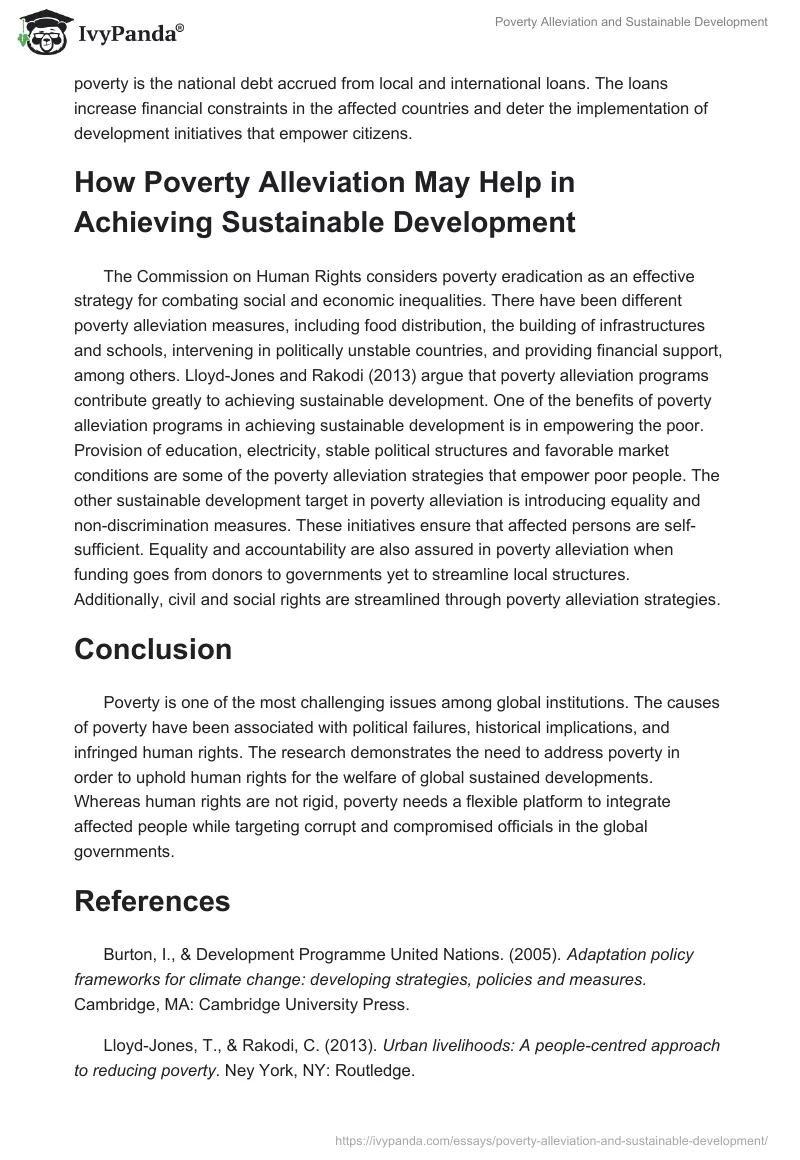Introduction
The Millennium Development Goals (MDG), which were set by 189 countries, consisted of global targets aimed at improving livelihoods and eliminating numerous deprivations, among them poverty. In fact, the countries considered poverty as the most serious problem and affirmed their dedication to eradicating extreme poverty and hunger. According to Tagler and Cozzarelli (2013), poverty is an economic condition that is characterized by sustained low levels of income. The status affects access to basic services of education, health, food, and shelter. The research focuses on the causes of poverty and the benefits of poverty alleviation in achieving sustainable development.
Causes of Poverty
Poverty is a long-term consequence of economic, social, and political failures. According to Williams (2013), an author with ‘The Borgen Project (NGO)’, causes of poverty are categorized into four major categories. One of the causes of poverty is discrimination and social inequality. Levels of inequalities in income distribution, access to basic amenities, legal structures, and information lead to serious economic disparities that subject victims to poverty. Additionally, Burton and Development Programme United Nations (2005) consider war and political instability as a leading cause of poverty. Political instabilities and wars affect insecurities and social and legal structures responsible for enhancing equitable distribution of resources and wealth. Ineffective policies expose people to exploitation and corruption. Sociopolitical failures affect literacy levels and access to information, which is vital in promoting self-actualization. Similarly, geopolitical histories and locations are other major causes of poverty. At-risk countries exposed to frequent natural catastrophes experience serious challenges in sustaining infrastructure development, effective information communications, and delivery of communal amenities. Additionally, historical political conflicts led to the depletion of vital resources from colonies of historic superpowers. The last cause of poverty is the national debt accrued from local and international loans. The loans increase financial constraints in the affected countries and deter the implementation of development initiatives that empower citizens.
How Poverty Alleviation May Help in Achieving Sustainable Development
The Commission on Human Rights considers poverty eradication as an effective strategy for combating social and economic inequalities. There have been different poverty alleviation measures, including food distribution, the building of infrastructures and schools, intervening in politically unstable countries, and providing financial support, among others. Lloyd-Jones and Rakodi (2013) argue that poverty alleviation programs contribute greatly to achieving sustainable development. One of the benefits of poverty alleviation programs in achieving sustainable development is in empowering the poor. Provision of education, electricity, stable political structures and favorable market conditions are some of the poverty alleviation strategies that empower poor people. The other sustainable development target in poverty alleviation is introducing equality and non-discrimination measures. These initiatives ensure that affected persons are self-sufficient. Equality and accountability are also assured in poverty alleviation when funding goes from donors to governments yet to streamline local structures. Additionally, civil and social rights are streamlined through poverty alleviation strategies.
Conclusion
Poverty is one of the most challenging issues among global institutions. The causes of poverty have been associated with political failures, historical implications, and infringed human rights. The research demonstrates the need to address poverty in order to uphold human rights for the welfare of global sustained developments. Whereas human rights are not rigid, poverty needs a flexible platform to integrate affected people while targeting corrupt and compromised officials in the global governments.
References
Burton, I., & Development Programme United Nations. (2005). Adaptation policy frameworks for climate change: developing strategies, policies and measures. Cambridge, MA: Cambridge University Press.
Lloyd-Jones, T., & Rakodi, C. (2013). Urban livelihoods: A people-centred approach to reducing poverty. Ney York, NY: Routledge.
Tagler, M. J., & Cozzarelli, C. (2013). Feelings toward the poor and beliefs about the causes of poverty: The role of affective-cognitive consistency in help-giving. The Journal of psychology, 147(6), 517-539.
Williams, D. (2013). What are Causes of Global Poverty? Web.


